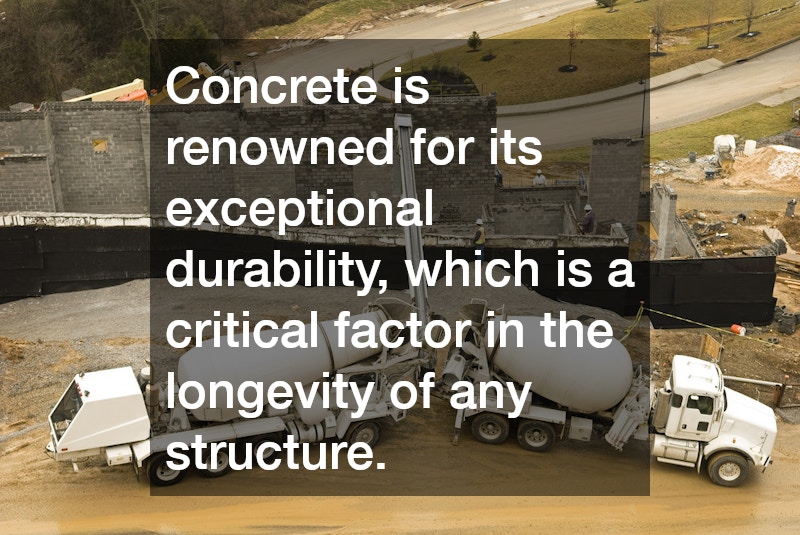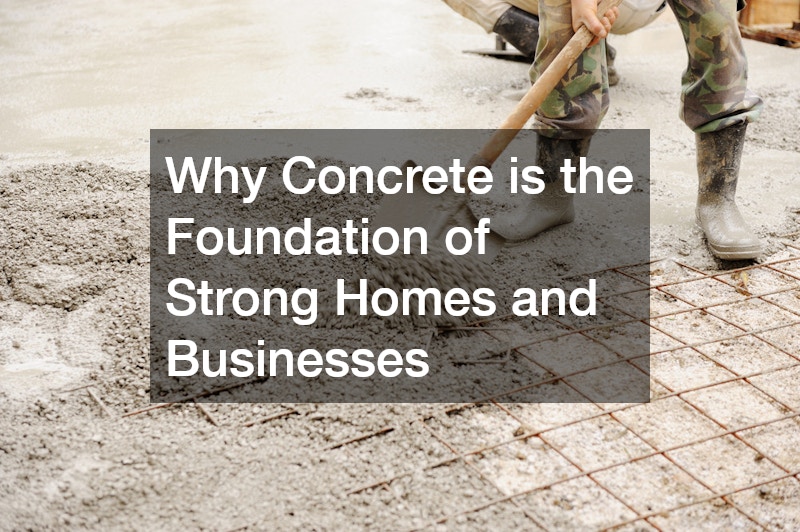Why Concrete is the Foundation of Strong Homes and Businesses
Introduction
Concrete is one of the most essential materials in the construction industry, serving as the backbone for both residential and commercial structures. Its widespread use is a testament to its versatility and unmatched strength, making it a preferred choice among builders and architects. This article delves into the compelling reasons why concrete is so pivotal for constructing strong homes and businesses, exploring its properties, energy efficiency contributions, and eco-friendly aspects.
What Makes Concrete a Preferred Material for Construction?
Durability
Concrete is renowned for its exceptional durability, which is a critical factor in the longevity of any structure. It withstands various stresses such as environmental changes, load-bearing demands, and weather impacts without compromising its structural integrity.
Buildings constructed with concrete enjoy a prolonged lifespan, making it a cost-effective choice over alternatives that may require frequent repairs or replacements.
The ability of concrete to endure harsh conditions makes it suitable for areas with extreme weather patterns, whether it’s penetrating heat, freezing temperatures, or heavy rainfall. This resilience ensures that both homes and businesses remain secure and reliable throughout the years. Compared to materials like wood, which can rot, or metal, which can corrode, concrete stands out as a robust solution for lasting construction.
Moreover, the durability of concrete reduces the need for additional reinforcing materials, making it a direct and efficient choice for builders. Its longevity is not just a product of its material composition but also a reflection of smart engineering practices that have been refined over decades. This durability ensures that concrete structures maintain their value and functionality longer, thereby contributing to the safety and stability of the built environment.
Adaptability
One of the most attractive features of concrete is its adaptability, allowing architects and builders to meet specific aesthetic and practical requirements. Concrete’s ability to take on different forms and textures means it can be tailored for a wide variety of uses, from sleek modern designs to rustic finishes. This flexibility is particularly beneficial in urban design, where space and style play crucial roles.
Architects take advantage of concrete’s versatile nature to innovate and push the boundaries of design. Whether it’s shaping concrete for intricate facades or utilizing it in a pre-cast format for quick and efficient assembly on-site, the options are virtually limitless. It provides the creative freedom needed to fulfill both functional and aesthetic project demands without sacrificing structural integrity.
Beyond aesthetic flexibility, concrete can be used in a variety of structural applications, from foundations and load-bearing walls to decorative elements and pavement. Its adaptability extends to engineering requirements as well, enabling the development of specialized mixes that address specific project needs, such as enhanced insulation or load-bearing capacity, thereby making it an indispensable construction material.
Cost-Effectiveness
Cost-effectiveness is another pivotal reason why concrete remains the go-to choice for builders worldwide. While the initial cost of concrete construction might align closely with or even exceed other materials, its long-term financial benefits are considerable. Thanks to its durability, concrete structures incur fewer maintenance costs over time, reducing the need for repairs and extensive upkeep.
Additionally, concrete’s ability to extend the lifespan of a building effectively lowers the total cost of ownership. Its thermal mass reduces energy expenses by maintaining interior temperatures, while its low permeability helps avoid moisture-related damages that can lead to costly structural issues. These inherent qualities make concrete an economical option for both residential and commercial developments.
The financial advantages extend beyond durability and maintenance. Concrete’s energy efficiency also plays a role in lowering monthly utility bills, offering further savings to property owners. When one considers the lifecycle costs, concrete emerges as a frontrunner due to its ability to offer resilience, energy efficiency, and minimal upkeep, contributing to its widespread adoption in construction projects.
How Does Concrete Contribute to Energy Efficiency in Buildings?
Thermal Mass
Concrete’s thermal mass properties make it a valuable contributor to energy-efficient buildings. By absorbing and slowly releasing heat, concrete helps stabilize indoor temperatures, reducing the reliance on heating and cooling systems. This natural regulation is particularly beneficial in climates with significant temperature fluctuations between day and night.
The thermal efficiency of concrete is a result of its density and ability to store heat. During warmer periods, concrete absorbs excess heat, which is then gradually released as temperatures decrease. This process minimizes the need for artificial heating, which is both energy-intensive and costly, making concrete an environmentally friendly choice.
Furthermore, integrating concrete with other passive solar design strategies can enhance these benefits even more. For example, positioning windows to maximize sunlight exposure or using shading devices to control the heat input can further optimize the building’s energy performance, driving down energy consumption and costs significantly.
Insulation Support
Concrete structures also contribute to improved building insulation. Concrete walls, when combined with appropriate insulation materials, can significantly enhance a building’s thermal envelope, preventing heat transfer and keeping interiors comfortable across seasons. This synergistic effect reduces energy demands by maintaining a balanced internal climate.
The dense nature of concrete acts as a barrier to external temperature variations, making it an ideal choice for exterior walls and foundations. Leveraging this characteristic with supplementary insulation enhances its performance, creating a robust protective layer that mitigates energy loss. This integration results in reduced reliance on HVAC systems, lowering energy consumption over time.
Integrating concrete with advanced insulation methods, such as insulated concrete forms (ICFs), further amplifies these benefits. ICFs combine the structural advantages of concrete with built-in insulation layers, creating a composite wall that offers both strength and superior thermal properties. Such innovative construction techniques underscore concrete’s role in sustainable building practices.
Energy Consumption Reduction
Concrete’s contribution to energy consumption reduction extends beyond its thermal properties. Its mass and density provide sound insulation, reducing noise pollution and creating quiet, comfortable living and working environments. This improvement in living conditions often translates to additional energy savings, as occupants are less likely to rely on electronic devices to create a conducive atmosphere.
Energy efficiency is further bolstered by concrete’s compatibility with renewable energy systems. For instance, concrete roofs can support solar panels, allowing property owners to harness clean energy effectively. This compatibility aligns with growing trends towards sustainable architecture and design, promoting the integration of concrete into eco-friendly building practices.
By facilitating lower energy consumption and supporting renewable energy systems, concrete not only benefits the environment but also results in financial savings for property owners. This dual advantage reinforces its role as a fundamental material in constructing energy-efficient homes and businesses, highlighting its contribution to reduced operational costs and environmental sustainability.
What Are the Eco-Friendly Aspects of Using Concrete?
Recyclability
Concrete’s recyclability is a significant factor in its eco-friendly profile. At the end of a structure’s life cycle, concrete can be crushed and repurposed into aggregate for new constructions, paving the way for a circular economy in the building industry. This recycling process minimizes waste and reduces the need for raw materials, helping decrease the environmental impact of construction activities.
The ability to reuse concrete not only alleviates the pressure on landfills but also conserves natural resources while reducing energy consumption associated with transporting and processing virgin materials. As the construction industry faces increasing sustainability demands, the capability to recycle and reuse concrete is becoming crucial in meeting green building certifications and standards.
In addition to reducing construction waste, recycled concrete contributes to other sustainable practices. It can be used as base material for roadwork or as part of water management systems, showcasing its versatility and reinforcing its position as a staple of eco-friendly construction methods.
Local Material Utilization
One of the environmental benefits of concrete is the potential to use locally sourced materials in its production. By utilizing local aggregates, sand, and cement, the need for long-distance transportation is minimized, significantly cutting down on carbon emissions associated with freight and logistics.
The use of regional materials not only supports local economies but also aligns with sustainable practices by reducing transportation’s ecological footprint. In many cases, locally sourced materials can match, if not surpass, imported options in terms of quality and cost-effectiveness, while also adhering to environmental regulations and standards.
Opting for local materials reduces dependency on international supply chains, making construction projects more resilient against economic fluctuations and enhancing their overall sustainability. It also fosters regional technological advancements and innovations in concrete production and utilization, further embedding concrete as an essential component of sustainable development.
Innovative Practices
The concrete industry is continuously evolving, with research and development leading to innovative practices aimed at reducing its environmental footprint. One such innovation is the development of low-carbon concrete, which replaces traditional cement with alternatives to cut down carbon emissions significantly.
Technological advancements have also led to the incorporation of waste materials, such as fly ash and slag, into concrete mixes. These substitutes not only recycle industrial by-products but also enhance the durability and thermal performance of concrete, yielding both environmental and economic benefits.
Additionally, developments in carbon capture technology are promising avenues for making concrete even more sustainable. By capturing and storing carbon dioxide during the curing process, these practices aim to neutralize emissions and align the industry with global climate goals. Such innovations are paving the way for a greener future, showcasing concrete’s adaptability even in the face of environmental challenges.
Conclusion
Concrete undeniably plays a pivotal role in building strong, efficient, and sustainable structures for homes and businesses. Its durability, adaptability, and cost-effectiveness make it a cornerstone of modern construction. Concrete’s ability to support energy efficiency efforts further solidifies its value, while its eco-friendly aspects provide a path towards sustainable building practices. Looking ahead, innovations in concrete technology promise even greater sustainability, ensuring that concrete remains an indispensable ally in the quest for greener construction solutions. If you’re looking to start a project soon, consider hiring a professional concrete contractor for the best results.



